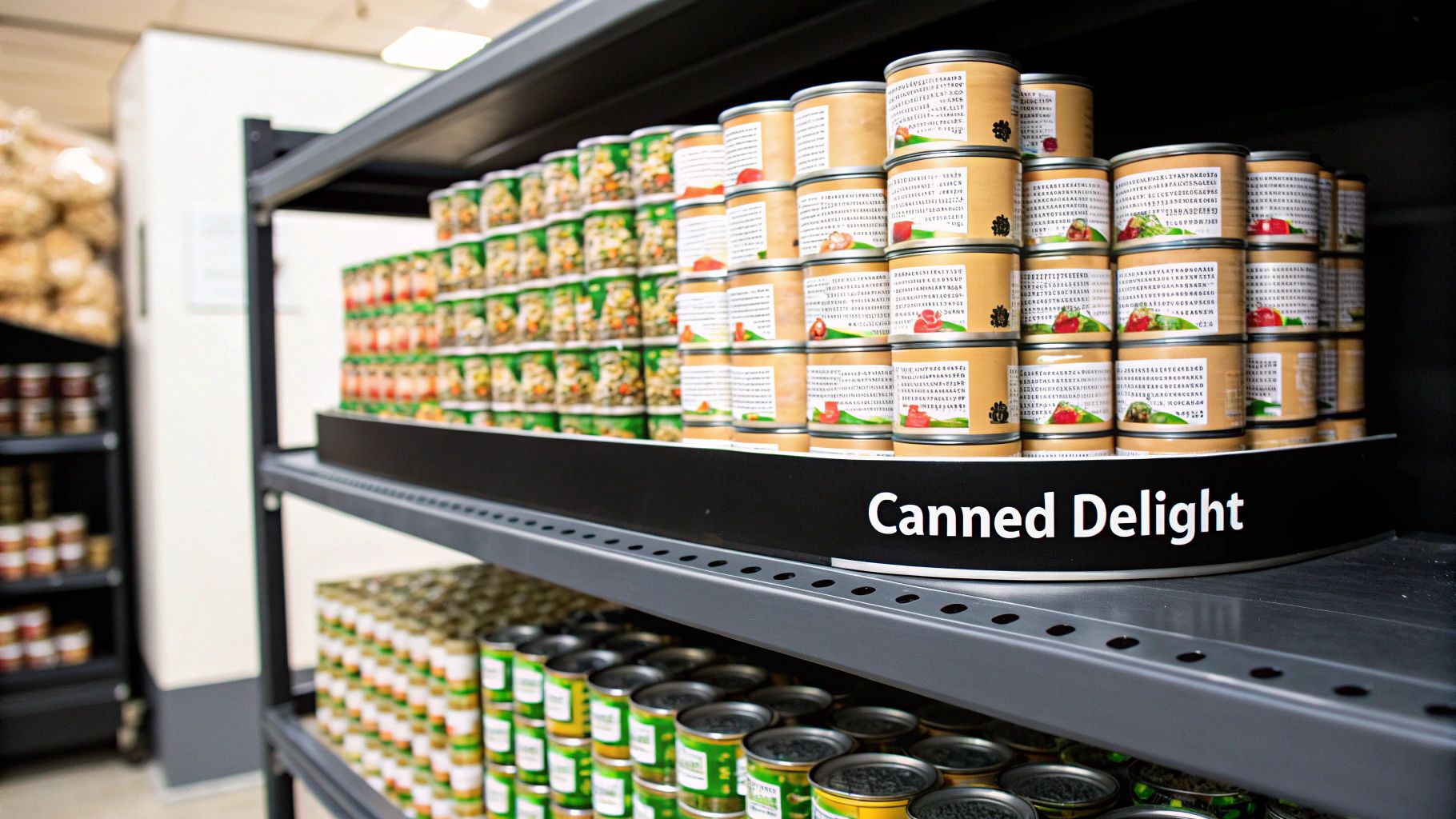The Birth of an Icon: Decoding SPAM's Name
What does SPAM stand for? The name isn't actually an acronym, but rather a portmanteau – a creative blend of two words. Like many beloved brands, its origins involve a bit of family connection, a modest prize, and a clever naming contest.
The iconic name came to life in 1937 when Ken Daigneau, an actor and brother of a Hormel Foods executive, won a $100 prize in a company contest to name their new canned meat product. He created 'Spam' as a simple mashup of "spiced ham" – though interestingly, the product contains very little ham and no notable spices. Learn more about SPAM's fascinating origin story.
From Spiced Ham to Global Icon: The Power of a Name
The choice of "Spam" turned out to be brilliant marketing. The short, snappy name was easy to say in any language, which helped fuel its worldwide growth. Its simple, open-ended meaning also allowed the brand to adapt and evolve, letting people embrace it as a versatile ingredient for countless dishes.
Wartime Necessity and Post-War Popularity
Spam's big break came during World War II, when the military shipped over 100 million pounds to feed troops in the Pacific. This massive distribution introduced the product to new cultures and established it as a reliable, long-lasting food source. After the war, its popularity continued to grow as people embraced its convenience and familiarity.
A Legacy Beyond the Can
The word "Spam" has taken on new meaning in the digital world, now commonly referring to unwanted email messages. This dual identity – beloved food product and annoying inbox clutter – shows how deeply the name has embedded itself in our culture. Few brand names have managed to shape both food history and internet vocabulary in quite the same way.
From Factory to Frontline: SPAM's Military Legacy
Initially created as an affordable meal during the Great Depression, SPAM took on new significance during World War II. What started as a simple canned meat product became essential military food and a symbol of American ingenuity. This beloved product, officially named "spiced ham", played a key role in feeding troops during the war.
Solving Supply Chain Challenges
Feeding soldiers in wartime presents major logistical hurdles, especially with fresh food's short shelf life. SPAM offered an effective solution – its special canning process meant it could be stored without refrigeration and shipped worldwide. The meat came pre-cooked, making it perfect for quick meals in combat zones where cooking facilities were limited.
Impact on Troop Nutrition and Morale
SPAM gave soldiers much-needed protein and energy when fresh food wasn't available. While taste opinions varied, having dependable meals helped maintain troop morale during uncertain times. The consistency of always having SPAM available provided comfort, even if meals sometimes felt repetitive.
Shaping Military Cuisine Strategy
Beyond basic sustenance, SPAM sparked creativity in military kitchens. Soldiers developed various ways to prepare it – from fritters to breakfast combinations with eggs. This flexibility helped SPAM gain acceptance and eventually influenced the food culture in many nations touched by the war. When it launched on July 5, 1937, SPAM was an innovative product that used pork shoulder, which wasn't in high demand at the time. Its long storage life and easy preparation made it especially valuable during the Depression years. Learn more about SPAM's history here).
A Global Culinary and Cultural Legacy
SPAM's most remarkable achievement may be its lasting cultural impact worldwide. First introduced through military supply chains, it became a cherished ingredient in many local cuisines. Today, SPAM remains especially popular in Hawaii, Guam, and the Philippines, where it features in traditional dishes and food festivals. What began as a practical solution has become deeply woven into global food culture – proof of its adaptability and staying power.
Inside SPAM: Evolution of a Classic Recipe
SPAM has been delighting fans with its unique taste for over 80 years. While the core recipe has stayed largely the same, Hormel Foods continues to develop new varieties to meet changing consumer preferences. Let's take a closer look at what makes this beloved canned meat product special.
Let's compare the nutritional content of different SPAM varieties:
| Product Type | Calories | Fat (g) | Protein (g) | Sodium (mg) |
|---|---|---|---|---|
| SPAM Classic | 180 | 16 | 7 | 790 |
| SPAM Lite | 140 | 12 | 7 | 580 |
| SPAM Low Sodium | 180 | 16 | 7 | 580 |
| SPAM Turkey | 150 | 13 | 8 | 690 |
The Science of Preservation and Shelf Life
One of SPAM's most notable features is its impressive shelf life. This comes from carefully designed preservation methods that keep the meat fresh and safe. The process starts with pre-cooking the meat and adding seasonings. Then, the mixture goes into cans that are sealed and heated to eliminate any harmful bacteria. These steps ensure SPAM stays good for years, making it perfect for emergency food supplies and everyday convenience.
Balancing Taste and Nutritional Concerns
As people become more health-conscious, SPAM has adapted while keeping its classic appeal. Hormel Foods now offers several alternatives including reduced sodium and lower fat options. They've also introduced fun flavors like teriyaki and jalapeño. The original SPAM contains twice as much fat as protein and has high sodium levels that some find concerning. Despite these nutritional factors, many people appreciate SPAM's affordability and convenience. Learn more about SPAM's history and impact on Britannica.
Ensuring Quality and Consistency: From Sourcing to Production
Making millions of consistent SPAM cans requires strict quality control at every step. From selecting premium pork shoulder to perfecting the seasoning mix, nothing is left to chance. Regular testing ensures each can meets Hormel's standards for taste and texture. This commitment to quality has helped SPAM maintain its reputation as a reliable product worldwide. The company continues researching new ways to improve while keeping what fans love about this classic meat.
Beyond the Can: SPAM's Digital Legacy
SPAM® brand meat has found an unexpected second identity in the world of technology. The name that once only meant a canned meat product now also refers to unwanted electronic messages, particularly junk email. This unusual journey from grocery store shelves to internet terminology shows how brand names can develop entirely new cultural meanings.
From Luncheon Meat to Unwanted Email: A Monty Python Sketch
The term "spam" for junk email originated from a famous 1970 Monty Python Flying Circus comedy sketch. In the skit, every menu item at a cafe contains SPAM, with the word repeated endlessly to the customer's frustration. Early internet users saw parallels between this annoying repetition and the flood of unwanted emails filling their inboxes. The lowercase "spam" soon became the standard term for these electronic intrusions.
Managing a Split Identity: The Brand's Response
Hormel Foods, which makes SPAM®, has taken an interesting approach to their brand name's new digital meaning. Rather than fighting this alternate use, they've accepted it with good humor. The company clearly distinguishes between their food product and unwanted email, while acknowledging the Monty Python connection that sparked the digital usage.
The Cultural Impact of a Shared Name
The word "spam" now lives a double life in our culture. It remains the name of a popular food with deep cultural roots in many communities. At the same time, it describes the unwanted messages that flood our email accounts daily. This split meaning shows how language can evolve and take on new significance in different settings.
SPAM Today: Moving Forward
Hormel Foods continues producing and promoting SPAM® while recognizing its unexpected place in digital culture. The brand has even incorporated playful references to its email namesake in marketing campaigns. Their success in handling this linguistic evolution demonstrates how brands can adapt when their names take on new cultural meanings.
Global Flavor: SPAM's Cultural Revolution
The story of SPAM goes far beyond its canned origins. This humble meat product has woven itself into cuisines worldwide, becoming a cherished ingredient across different cultures. Let's explore how SPAM has found its way into kitchens around the globe and shaped local food traditions.
Here's a look at how different cultures have embraced SPAM in their signature dishes:
| Country/Region | Dish Name | Description | Cultural Significance |
|---|---|---|---|
| Hawaii | SPAM Musubi | Grilled SPAM on rice wrapped in nori | Iconic local snack found everywhere from corner stores to restaurants |
| South Korea | Budae Jjigae | Army stew with SPAM, noodles and kimchi | Emerged post-war, now a beloved comfort food |
| Philippines | SPAM Adobo | SPAM cooked in vinegar, soy sauce and garlic | Creative adaptation of a classic Filipino cooking style |
| Guam | SPAM Fried Rice | Diced SPAM stir-fried with day-old rice and vegetables | Popular breakfast dish representing American influence |
A Pacific Island Staple: From Military Rations to Local Favorite
SPAM's journey in the Pacific Islands began during World War II when it arrived as military provisions. What started as a necessity soon became a treasured part of local cooking in Hawaii, Guam, and the Philippines. Each culture adapted SPAM to complement their traditional flavors and cooking methods.
In Hawaii, SPAM musubi stands out as an iconic fusion food – grilled SPAM perched on rice and wrapped in seaweed. You'll find this portable snack everywhere from beach coolers to convenience stores. Guam has embraced SPAM in everyday cooking, while Filipino cooks often incorporate it into beloved dishes like adobo.
Asian Influences and Creative Cooking
SPAM's influence extends deep into Asian cuisine. In South Korea, it's considered a premium gift item, often featured in elaborate gift sets during holidays. Local preferences have even inspired special SPAM varieties made just for Asian markets.
This adaptability makes SPAM perfect for fusion cooking. Chefs blend cultural influences to create new dishes that honor both SPAM's origins and local tastes. From Korean army stew (budae jjigae) to Filipino SPAM sisig, these creative combinations show how one ingredient can bridge different culinary traditions.
Beyond the Pacific: SPAM's Growing Global Appeal
While SPAM remains most popular in Pacific and Asian regions, its reach continues to grow worldwide. Creative cooks everywhere are finding new ways to use this versatile ingredient. Whether it's adding crispy SPAM to gourmet burgers or incorporating it into fresh salads, chefs keep discovering innovative ways to showcase SPAM's potential.
From its modest beginnings, SPAM has evolved into a true food phenomenon that connects different cultures through shared appreciation. Its ability to complement diverse cooking styles while maintaining its distinct character makes it more than just a convenience food – it's become a cultural bridge on plates around the world.
Innovation Forward: SPAM's Next Chapter
From its humble beginnings as a wartime staple to becoming a global food icon, SPAM has proven its staying power. But what does the future hold for this classic canned meat? Let's explore how SPAM is evolving and what new developments might be on the horizon.
Adapting to Modern Food Trends
Today's consumers want healthier options and sustainable food choices. SPAM has already started adapting – they've launched SPAM Lite and SPAM Low Sodium to give health-conscious customers more options. This shows their commitment to creating products that fit different dietary needs.
The growing popularity of plant-based alternatives creates an interesting challenge. While SPAM could explore new protein sources, they might instead focus on their product's unique benefits. Their unmatched shelf life and convenience are advantages that many meat alternatives can't match.
Sustainability and Ethical Sourcing
More people care about where their food comes from and its environmental impact. For SPAM, this means looking at ways to make their processes more earth-friendly. They could switch to eco-friendly packaging, reduce their carbon footprint, or focus on ethical ingredient sourcing. These changes would appeal to environmentally aware shoppers while building trust in the brand.
Marketing to New Generations
Connecting with younger customers means speaking their language. SPAM has found success on social media platforms where younger audiences spend time. Future marketing might include more creative online campaigns, collaborations with food influencers, or sharing modern recipes that appeal to younger tastes.
Maintaining Relevance in a Digital World
SPAM's online presence has grown beyond its association with unwanted emails. The brand could expand into online shopping with special web-only products or custom promotions. They might also use customer data to better understand buying habits and improve their marketing.
To help businesses avoid email delivery issues and maintain clean contact lists, EmailAddress.ai offers powerful verification tools. Their service helps ensure marketing messages reach the right inboxes while avoiding spam filters.





